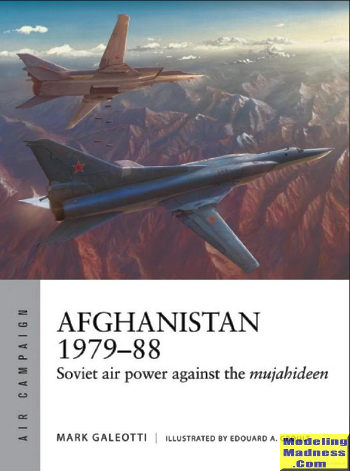 Subtitled:
Soviet air power against the
mujahideen
Subtitled:
Soviet air power against the
mujahideen
The Soviet invasion of Afghanistan in December, 1979 started out as a brief show of force to assist the People's Democratic Party of Afghanistan (PDPA) install a new and more Soviet friendly leader. Instead, it turned out to be just the start of a decade long fight that technically the Soviets neither won nor lost. The conflict would be fought as much in the air as on the ground. For, although the rebel mujahadeen had no air force, Soviet air power would accompany every substantial ground operation. Much like the USAF in Vietnam, the Soviet Air Force would try to use aircraft developed to fight a conventional war in Europe to combat an insurgency. However, they would manage to learn and adapt enough to keep the war from becoming a crushing defeat.
Afghanistan 1979-88 – Soviet air power against the mujahideen chronicles the Soviet and the mujahadeen's capabilities, the Soviet Union's campaign objectives, the campaign itself, and provides an analysis of the aftermath. The book is lavishly illustrated with black and color photos, colored artwork, maps, and diagrams of various attack profiles. The book describes in some detail the operational uses of the various aircraft used in the conflict with some being abject failures (Yak 38) and others becoming unqualified successes (Mi 24 and Su 25). Considerable attention is also paid to telling how essential the roles of the fixed wing aircraft and helicopters that hauled people and cargo in support of the ground elements during the conflict. The importance of their roles cannot be understated as much of Afghanistan is not accessible by roads. The book also details the effect that the introduction of the Stinger hand held anti-aircraft missile had on the conflict. The missile's success being due more to how it forced the Soviets to change tactics than to how many aircraft it actually downed. The book also clears up the misconception that Afghanistan was the Soviet Union's “Vietnam”. The two conflicts were fought at much different levels of intensity as evidenced by the Soviet Union's less than 500 aircraft lost in Afghanistan compared to the more than 10,000 aircraft that the USA lost in Vietnam. Editor's Note: Here is the loss tally for Vietnam from all services: (3,744 planes, 5,607 helicopters and 578 UAVs )
Although, Afghanistan 1979-88 – Soviet air power against the mujahideen, is not specifically directed towards modelers, it provides an inexpensive and interesting primer on a conflict that seemingly repeats itself with depressing regularity. A conflict that more than one superpower didn't as much lose as they just decided that it wasn't worth fighting anymore. Recommended to anyone interested in military history in general and interested in the Cold War in particular.
April 2024